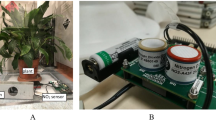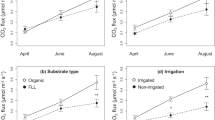Abstract
High indoor CO2 concentrations and low relative humidity (RH) create an array of well-documented human health issues. Therefore, assessing houseplants’ potential as a low-cost approach to CO2 removal and increasing RH is important. We investigated how environmental factors such as ‘dry’ (< 0.20 m3 of water per m3 of substrate, m3 m−3) or ‘wet’ (> 0.30 m3 m−3) growing substrates, and indoor light levels (‘low’ 10 μmol m−2 s−1, ‘high’ 50 μmol m−2 s−1, and ‘very high’ 300 μmol m−2 s−1) influence the plants’ net CO2 assimilation (‘A’) and water vapour loss. Seven common houseplant taxa—representing a variety of leaf types and sizes—were studied for their ability to assimilate CO2 across a range of indoor light levels. Additionally, to assess the plants’ potential contribution to RH increase, the plants’ evapo-transpiration (ET) was measured. At typical ‘low’ indoor light levels, ‘A’ rates were generally low (< 3.9 mg h−1). Differences between ‘dry’ and ‘wet’ plants at typical indoor light levels were negligible in terms of room-level impact. Light compensation points (i.e. the light level where the CO2 assimilation equals zero) were in the typical indoor light range (1–50 μmol m−2 s−1) only for two studied Spathiphyllum wallisii cultivars and Hedera helix; these plants would thus provide the best CO2 removal indoors. Additionally, increasing indoor light levels to 300 μmol m−2 s−1 would, in most species, significantly increase their potential to assimilate CO2. Species which assimilated the most CO2 also contributed most to increasing RH.



Similar content being viewed by others
Abbreviations
- RH:
-
Relative humidity (%)
- DLI:
-
Daily light integral (mol m−2 d−1)
- SMC:
-
Substrate moisture content (m3 m−3)
- LCP:
-
Light compensation point (μmol m−2 s−1)
- ET:
-
Evapo-transpiration (g)
- PPM:
-
Uptake or emission of CO2 by potted-plant microcosm
- LA:
-
Leaf area (m2)
- ETLA:
-
Evapo-transpiration per unit leaf area (g cm−2)
References
Abusharha AA, Pearce EI (2013) The effect of low humidity on the human tear film. Cornea 32:429–434. https://doi.org/10.1097/ICO.0b013e31826671ab
Arundel AV, Sterling EM, Biggin JH, Sterling TD (1986) Indirect health-effects of relative-humidity in indoor environments. Environ Health Perspect 65:351–361. https://doi.org/10.2307/3430203
Berglund LG (1998) Comfort and humidity. ASHRAE J 40:35–41
Bin S (2002) A field study of mould growth and indoor health conditions in Auckland dwellings. Archit Sci Rev 45:275–284. https://doi.org/10.1080/00038628.2002.9696941
Boyce P, Raynham P (2009) The Sll lighting handbook. The Society of Light and Lighting, London
Burton AL, Pennisi SV, van Iersel MW (2007) Morphology and postharvest performance of Geogenanthus undatus C. Koch & Linden ‘Inca’ after application of ancymidol or flurprimidol. Hortscience 42:544–549
Charoenkit S, Yiemwattana S (2016) Living walls and their contribution to improved thermal comfort and carbon emission reduction: a review. Build Environ 105:82–94. https://doi.org/10.1016/j.buildenv.2016.05.031
Egea G, Perez-Urrestarazu L, Gonzalez-Perez J et al (2014) Lighting systems evaluation for indoor living walls. Urban For Urban Green 13:475–483. https://doi.org/10.1016/j.ufug.2014.04.009
Erdmann CA, Apte MG (2004) Mucous membrane and lower respiratory building related symptoms in relation to indoor carbon dioxide concentrations in the 100-building base dataset. Indoor Air 14:127–134. https://doi.org/10.1111/j.1600-0668.2004.00298.x
Flexas J, Bota J, Galmes J et al (2006) Keeping a positive carbon balance under adverse conditions: responses of photosynthesis and respiration to water stress. Physiol Plant 127:343–352. https://doi.org/10.1111/j.1399-3054.2006.00621.x
Frankel M, Beko G, Timm M et al (2012) Seasonal variations of indoor microbial exposures and their relation to temperature, relative humidity, and air exchange rate. Appl Environ Microbiol 78:8289–8297. https://doi.org/10.1128/aem.02069-12
Gaihre S, Semple S, Miller J, Fielding S, Turner S (2014) Classroom carbon dioxide concentration, school attendance, and educational attainment. J Sch Health 84:569–574. https://doi.org/10.1111/josh.12183
Galindo F, Lima JC, Luis SV, Melo MJ, Parola AJ, Pina F (2005) Water/humidity and ammonia sensor, based on a polymer hydrogel matrix containing a fluorescent flavylium compound. J Mater Chem 15:2840–2847. https://doi.org/10.1039/b500512d
Hawkins G (2011) Rules of Thumb: guidelines for building services. BSRIA, Bracknell
Hersoug LG, Sjodin A, Astrup A (2012) A proposed potential role for increasing atmospheric Co2 as a promoter of weight gain and obesity. Nutr Diabetes 2:e31. https://doi.org/10.1038/nutd.2012.2
Hesaraki A, Myhren JA, Holmberg S (2015) Influence of different ventilation levels on indoor air quality and energy savings: a case study of a single-family house. Sustain Cities Soc 19:165–172. https://doi.org/10.1016/j.scs.2015.08.004
Huang L, Zhu Y, Ouyang Q, Cao B (2012) A study on the effects of thermal, luminous, and acoustic environments on indoor environmental comfort in offices. Build Environ 49:304–309. https://doi.org/10.1016/j.buildenv.2011.07.022
Jeong SJ, Song JS, Kim WS et al (2008) Evaluation of selected foliage plants for improvement of indoor humidity. Hortic Environ Biotechnol 49:439–446
Kim KJ, Il Jeong M, Lee D et al (2010) Variation in formaldehyde removal efficiency among indoor plant species. Hortscience 45:1489–1495
Lai ACK, Mui KW, Wong LT, Law LY (2009) An evaluation model for indoor environmental quality (Ieq) acceptance in residential buildings. Energy Build 41:930–936. https://doi.org/10.1016/j.enbuild.2009.03.016
Lawlor DW, Cornic G (2002) Photosynthetic carbon assimilation and associated metabolism in relation to water deficits in higher plants. Plant Cell Environ 25:275–294. https://doi.org/10.1046/j.0016-8025.2001.00814.x
Lim YW, Kim HH, Yang JY, Kim KJ, Lee JY, Shin DC (2009) Improvement of indoor air quality by houseplants in new-built apartment buildings. J Jpn Soc Hortic Sci 78:456–462
Lobo FDA, de Barros MP, Dalmagro HJ et al (2013) Fitting net photosynthetic light-response curves with Microsoft Excel - a critical look at the models. Photosynthetica 51:445–456. https://doi.org/10.1007/s11099-013-0045-y
Lohr VI, PearsonMims CH (1996) Particulate matter accumulation on horizontal surfaces in interiors: influence of foliage plants. Atmos Environ 30:2565–2568. https://doi.org/10.1016/1352-2310(95)00465-3
Lowen AC, Mubareka S, Steel J, Palese P (2007) Influenza virus transmission is dependent on relative humidity and temperature. PLoS Pathog 3:1470–1476. https://doi.org/10.1371/journal.ppat.0030151
Mateus NM, da Graca GC (2017) Simulated and measured performance of displacement ventilation systems in large rooms. Build Environ 114:470–482. https://doi.org/10.1016/j.buildenv.2017.01.002
Nieuwenhuis M, Knight C, Postmes T, Haslam SA (2014) The relative benefits of green versus lean office space: three field experiments. J Exp Psychol Appl 20:199–214. https://doi.org/10.1037/xap0000024
Oh GS, Jung GJ, Seo MH, Im YB (2011) Experimental study on variations of Co2 concentration in the presence of indoor plants and respiration of experimental animals. Hortic Environ Biotechnol 52:321–329. https://doi.org/10.1007/s13580-011-0169-6
Pegas PN, Alves CA, Nunes T, Bate-Epey EF, Evtyugina M, Pio CA (2012) Could houseplants improve indoor air quality in schools? J Toxicol Environ Health 75:1371–1380. https://doi.org/10.1080/15287394.2012.721169
Pennisi SV, van Iersel MW (2012) Quantification of carbon assimilation of plants in simulated and in situ interiorscapes. Hortscience 47:468–476
Persily A, de Jonge L (2017) Carbon dioxide generation rates for building occupants. Indoor Air 27:868–879. https://doi.org/10.1111/ina.12383
Prioul JL, Chartier P (1977) Partitioning of transfer and carboxylation components of intracellular resistance to photosynthetic Co2 fixation - critical analysis of methods used. Ann Bot 41:789–800. https://doi.org/10.1093/oxfordjournals.aob.a085354
Raanaas RK, Evensen KH, Rich D, Sjøstrøm G, Patil G (2011) Benefits of indoor plants on attention capacity in an office setting. J Environ Psychol 31:99–105. https://doi.org/10.1016/j.jenvp.2010.11.005
Raji B, Tenpierik MJ, van den Dobbelsteen A (2015) The impact of greening systems on building energy performance: a literature review. Renew Sust Energ Rev 45:610–623. https://doi.org/10.1016/j.rser.2015.02.011
Raza SH, Shylaja G, Murthy MSR, Bhagyalakshmi O (1991) The contribution of plants for Co2 removal from indoor air. Environ Int 17:343–347. https://doi.org/10.1016/0160-4120(91)90021-h
Royal Horticultural Society (2017) Advice: houseplants. Royal Horticultural Society. https://www.rhs.org.uk/advice/profile?pid=290#section-5 Accessed 14 August 2018
Satish U, Mendell MJ, Shekhar K, Hotchi T, Sullivan D, Streufert S, Fisk W(B)J (2012) Is Co2 an indoor pollutant? Direct effects of low-to-moderate Co2 concentrations on human decision-making performance. Environ Health Perspect 120:1671–1677. https://doi.org/10.1289/ehp.1104789
Seppanen OA, Fisk WJ, Mendell MJ (1999) Association of ventilation rates and Co2 concentrations with health and other responses in commercial and institutional buildings. Indoor Air 9:226–252. https://doi.org/10.1111/j.1600-0668.1999.00003.x
Sunwoo Y, Chou C, Takeshita J, Murakami M, Tochihara Y (2006) Physiological and subjective responses to low relative humidity in young and elderly men. J Physiol Anthropol 25:229–238. https://doi.org/10.2114/jpa2.25.229
Tan CL, Wong NH, Tan PY, Ismail M, Wee LY (2017) Growth light provision for indoor greenery: a case study. Energy Build 144:207–217. https://doi.org/10.1016/j.enbuild.2017.03.044
Thimijan RW, Heins RD (1983) Photometric, radiometric, and quantum light units of measure - a review of procedures for interconversion. Hortscience 18:818–822
Thomsen JD, Sonderstrup-Andersen HKH, Muller R (2011) People-plant relationships in an office workplace: perceived benefits for the workplace and employees. Hortscience 46:744–752
Torpy FR, Irga PJ, Burchett MD (2014) Profiling indoor plants for the amelioration of high Co2 concentrations. Urban For Urban Green 13:227–233. https://doi.org/10.1016/j.ufug.2013.12.004
Torpy FR, Zavattaro M, Irga PJ (2017) Green wall technology for the phytoremediation of indoor air: a system for the reduction of high Co2 concentrations. Air Qual Atmos Health 10:575–585. https://doi.org/10.1007/s11869-016-0452-x
Vaz Monteiro M, Blanusa T, Verhoef A et al (2016) Relative importance of transpiration rate and leaf morphological traits for the regulation of leaf temperature. Aust J Bot 64:32–44. https://doi.org/10.1071/bt15198
Vehvilainen TY, Lindholm H, Rintamaki H et al (2016) High indoor Co2 concentrations in an office environment increases the transcutaneous Co2 level and sleepiness during cognitive work. J Occup Environ Hyg 13:19–29. https://doi.org/10.1080/15459624.2015.1076160
Yang DS, Pennisi SV, Son KC, Kays SJ (2009) Screening indoor plants for volatile organic pollutant removal efficiency. Hortscience 44:1377–1381
Yeh N, Chung JP (2009) High-brightness LEDs-energy efficient lighting sources and their potential in indoor plant cultivation. Renew Sust Energ Rev 13:2175–2180. https://doi.org/10.1016/j.rser.2009.01.027
Zhang H, Yoshino H (2010) Analysis of indoor humidity environment in Chinese residential buildings. Build Environ 45:2132–2140. https://doi.org/10.1016/j.buildenv.2010.03.011
Zhang X, Wargocki P, Lian Z (2017) Physiological responses during exposure to carbon dioxide and bioeffluents at levels typically occurring indoors. Indoor Air 27:65–77. https://doi.org/10.1111/ina.12286
Acknowledgments
This work was supported by the Royal Horticultural Society and the Engineering and Physical Sciences Research Council (EPSRC). The authors would also like to thank Dr. Dalila Touhami, Dr. Fiona Lahive, Dr. Sarah Kemp, Rob Stirling, Val Jasper, Matthew Richardson, and Will Johnson for their practical guidance and support.
Author information
Authors and Affiliations
Corresponding author
Ethics declarations
Conflict of interest
The authors declare that they have no conflict of interest.
Electronic supplementary material
ESM 1
(DOCX 19 kb)
Rights and permissions
About this article
Cite this article
Gubb, C., Blanusa, T., Griffiths, A. et al. Can houseplants improve indoor air quality by removing CO2 and increasing relative humidity?. Air Qual Atmos Health 11, 1191–1201 (2018). https://doi.org/10.1007/s11869-018-0618-9
Received:
Accepted:
Published:
Issue Date:
DOI: https://doi.org/10.1007/s11869-018-0618-9




